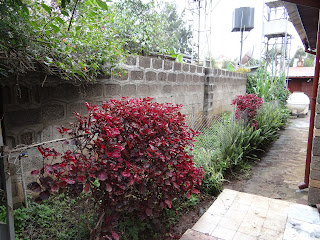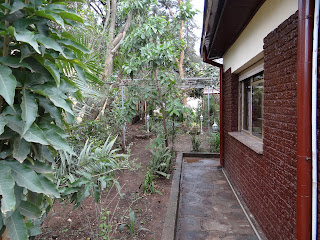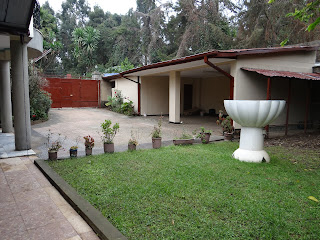There are many things to see in Ethiopia. Since Michael is already hard at work, I have time to contemplate our next adventures. I know when the staff come back for the new school year, they will help me to add to this list! I can't wait to experience these places myself! This page is in progress!
Outside of Addis Ababa:
1. Lalibela
The small town of Lalibela in Ethiopia is home to one of the world's most astounding sacred sites: eleven rock-hewn churches, each carved entirely out of a single block of granite with its roof at ground level.
Were it not for these extraordinary churches, Lalibela would almost certainly be well off the tourist radar. A dusty rural town nestled into rolling countryside, Lalibela only recently received electricity. It has few motorized vehicles, no gas stations and no paved streets. Isolated from the modern world, the town goes about its business much as it has for several hundred years.
Of Lalibela's 8-10,000 people, over 1,000 are priests. Religious ritual is central to the life of the town, with regular processions, extensive fasts, crowds of singing and dancing priests. This, combined with its extraordinary religious architecture and simplicity of life, gives the city of Lalibela a distinctively timeless, almost biblical atmosphere.
2. Tigray
Tigray also has rock-hewn churches. Similar in design to those of Lalibela. Some of the churches are considered earlier than those of Lalibela, perhaps dating from the eighth century. They are often located at the top of cliffs or steep hills, for security. For example, Tigray's ancient Debre Damo monastery is accessible only by climbing a rope 25 meters up a sheer cliff.
3. Aksum (also spelled Axum)
Aksum is the name of a powerful, urban Kingdom in Ethiopia, that flourished in the centuries before and after the time of Christ. The town is littered with the ruins of palaces, underground tombs, stelae (obelisks), and inscriptions. 98% of Aksum remains unexcavated. No longer a wealthy metropolis, the town continues to flourish as a center of local trade. Around the crumbling palaces, farmers are plowing their land, village boys splash in the Queen of Sheba's Bath, and hurrying past the
towering stelae are the market-goers and their donkeys
4. Gonder (also spelled Gondar)
Gonder has been called Africa's Camelot, and with its series of castles and churches.
The modern city of Gonder is popular as a tourist attraction for its many ruins in the Royal Enclosure, from which the Emperors once reigned. The most famous buildings in the city lie in the Royal Enclosure, which include Fasilides castle, Iyasu's Palace, Dawit's Hall, a banqueting hall, stables, Mentewab's Castle, a chencellery, library and three churches. Near the city lie Fasilides' Bath, home to an annual ceremony where it is blessed and then opened for bathing; the Qusquam complex, built by Empress Mentewab; the eighteenth century Ras Mikael Sehul's Palace and the Debre Berhan Selassie Church.
Downtown Gondar shows the influence of the Italian occupation of the late 1930s. The main piazza features shops, a cinema, and other public buildings. Villas and flats in the nearby quarter that once housed occupation officials and colonists are also of interest.
5. Simien Mountains National Park

According to Homer, the Simien Mountains awere the playground of the Greek gods, who came here to play chess...enough said. We have to go!
Simien Mountains have several jagged peaks of solidified lava that are separated by deep valleys to form an amazing landscape. The mountains are also home to some of the world’s rarest animals, including the Walia Ibex, which is not found anywhere else in the world, as well as the
Ethiopian wolf and Gelada Baboon.

6. Lake Tana
Lake Tana is the source of the Blue Nile and is the largest lake in Ethiopia. The lake discharges into the Blue Nile, which regulates the flow to the Blue Nile Falls (Tis Abbai), and a hydro-power station.
The thirty-seven islands of Lake Tana shelter twenty monasteries. Because of their isolation they were used to store art treasures and religious relics from all parts of the country. Tradition says the Ark of the Covenant was kept on one of these islands when Axum was endangered, and the remains of five Emperors - including Fasilidas - are to be found at Daga Istafanos.
Michael wants to raft the Blue Nile. We were told to watch out for the hippos!
7. Harar
For centuries, Harar has been a major commercial center, linked by the trade routes with the rest of Ethiopia, the entire Horn of Africa, the Arabian Peninsula, and, through its ports, the outside world. It has 82 mosques, three of which date from the 10th century, and 102 shrines.
Medhane Alem church, built at the end of the 19th century, is in the town centre and contains excellent examples of traditional regional art.
The Community Museum, also in the town center, has displays relating to the way of life in earlier times.
The 16th century Grand Mosque, with is beautiful twin towers and slender minaret lies on the road to the Erer Gate.
The market place is regarded as one of the most colourful in all Ethiopia. It known for its silversmiths, and there are beautiful necklaces, bracelets and chains to be found. The basketry is also impressive. There are two markets in Harar, the Christian and the Muslim, which are separated from one another.
The Ahmar Mountains around Harar produce some of the best coffee in Ethiopia...yummy!

The Hyena Men of Harar feed to the wild hyenas usually about 100 metres outside the Fallana Gate of the old city walls of the town. Hyenas appear just after sunset to take food from their hands or mouths in this case...
8. Nechisar National Park
Outside of Addis Ababa:
1. Lalibela
The small town of Lalibela in Ethiopia is home to one of the world's most astounding sacred sites: eleven rock-hewn churches, each carved entirely out of a single block of granite with its roof at ground level.
Were it not for these extraordinary churches, Lalibela would almost certainly be well off the tourist radar. A dusty rural town nestled into rolling countryside, Lalibela only recently received electricity. It has few motorized vehicles, no gas stations and no paved streets. Isolated from the modern world, the town goes about its business much as it has for several hundred years.
Of Lalibela's 8-10,000 people, over 1,000 are priests. Religious ritual is central to the life of the town, with regular processions, extensive fasts, crowds of singing and dancing priests. This, combined with its extraordinary religious architecture and simplicity of life, gives the city of Lalibela a distinctively timeless, almost biblical atmosphere.
2. Tigray
Tigray also has rock-hewn churches. Similar in design to those of Lalibela. Some of the churches are considered earlier than those of Lalibela, perhaps dating from the eighth century. They are often located at the top of cliffs or steep hills, for security. For example, Tigray's ancient Debre Damo monastery is accessible only by climbing a rope 25 meters up a sheer cliff.
3. Aksum (also spelled Axum)
Aksum is the name of a powerful, urban Kingdom in Ethiopia, that flourished in the centuries before and after the time of Christ. The town is littered with the ruins of palaces, underground tombs, stelae (obelisks), and inscriptions. 98% of Aksum remains unexcavated. No longer a wealthy metropolis, the town continues to flourish as a center of local trade. Around the crumbling palaces, farmers are plowing their land, village boys splash in the Queen of Sheba's Bath, and hurrying past the
towering stelae are the market-goers and their donkeys
4. Gonder (also spelled Gondar)
Gonder has been called Africa's Camelot, and with its series of castles and churches.
The modern city of Gonder is popular as a tourist attraction for its many ruins in the Royal Enclosure, from which the Emperors once reigned. The most famous buildings in the city lie in the Royal Enclosure, which include Fasilides castle, Iyasu's Palace, Dawit's Hall, a banqueting hall, stables, Mentewab's Castle, a chencellery, library and three churches. Near the city lie Fasilides' Bath, home to an annual ceremony where it is blessed and then opened for bathing; the Qusquam complex, built by Empress Mentewab; the eighteenth century Ras Mikael Sehul's Palace and the Debre Berhan Selassie Church.
Downtown Gondar shows the influence of the Italian occupation of the late 1930s. The main piazza features shops, a cinema, and other public buildings. Villas and flats in the nearby quarter that once housed occupation officials and colonists are also of interest.

According to Homer, the Simien Mountains awere the playground of the Greek gods, who came here to play chess...enough said. We have to go!
Simien Mountains have several jagged peaks of solidified lava that are separated by deep valleys to form an amazing landscape. The mountains are also home to some of the world’s rarest animals, including the Walia Ibex, which is not found anywhere else in the world, as well as the

6. Lake Tana
Lake Tana is the source of the Blue Nile and is the largest lake in Ethiopia. The lake discharges into the Blue Nile, which regulates the flow to the Blue Nile Falls (Tis Abbai), and a hydro-power station.
The thirty-seven islands of Lake Tana shelter twenty monasteries. Because of their isolation they were used to store art treasures and religious relics from all parts of the country. Tradition says the Ark of the Covenant was kept on one of these islands when Axum was endangered, and the remains of five Emperors - including Fasilidas - are to be found at Daga Istafanos.
Michael wants to raft the Blue Nile. We were told to watch out for the hippos!
7. Harar
For centuries, Harar has been a major commercial center, linked by the trade routes with the rest of Ethiopia, the entire Horn of Africa, the Arabian Peninsula, and, through its ports, the outside world. It has 82 mosques, three of which date from the 10th century, and 102 shrines.
Medhane Alem church, built at the end of the 19th century, is in the town centre and contains excellent examples of traditional regional art.
The Community Museum, also in the town center, has displays relating to the way of life in earlier times.
The 16th century Grand Mosque, with is beautiful twin towers and slender minaret lies on the road to the Erer Gate.
The market place is regarded as one of the most colourful in all Ethiopia. It known for its silversmiths, and there are beautiful necklaces, bracelets and chains to be found. The basketry is also impressive. There are two markets in Harar, the Christian and the Muslim, which are separated from one another.
The Ahmar Mountains around Harar produce some of the best coffee in Ethiopia...yummy!

The Hyena Men of Harar feed to the wild hyenas usually about 100 metres outside the Fallana Gate of the old city walls of the town. Hyenas appear just after sunset to take food from their hands or mouths in this case...
8. Nechisar National Park






.jpg)














